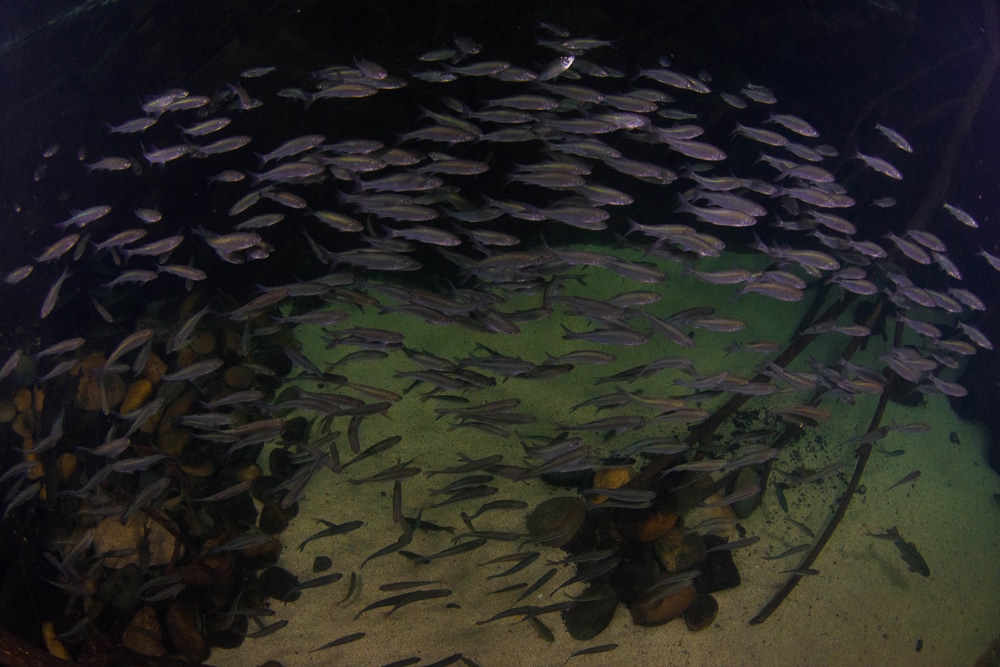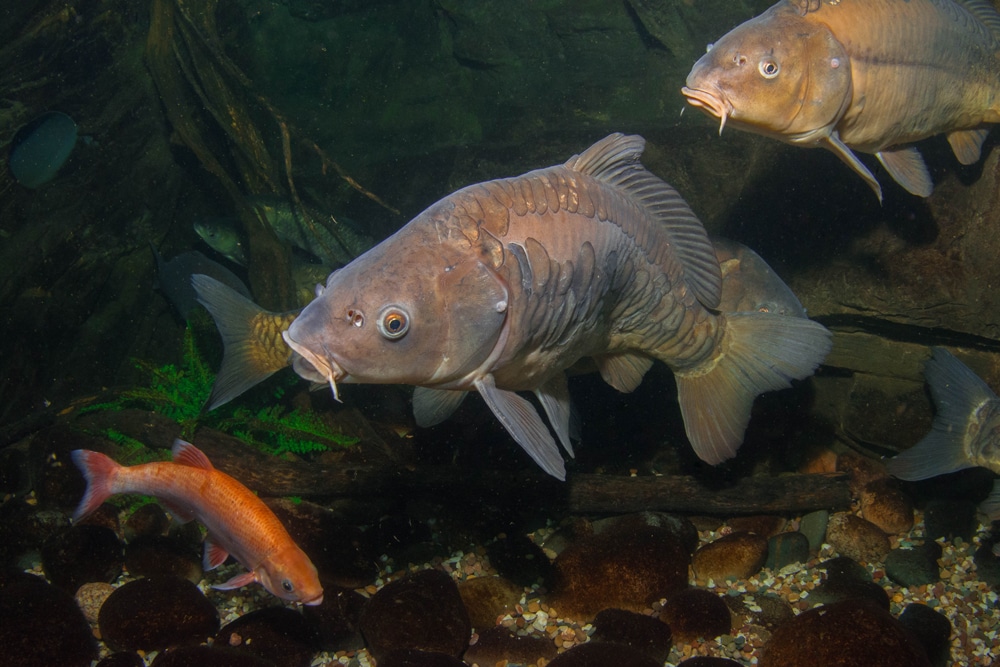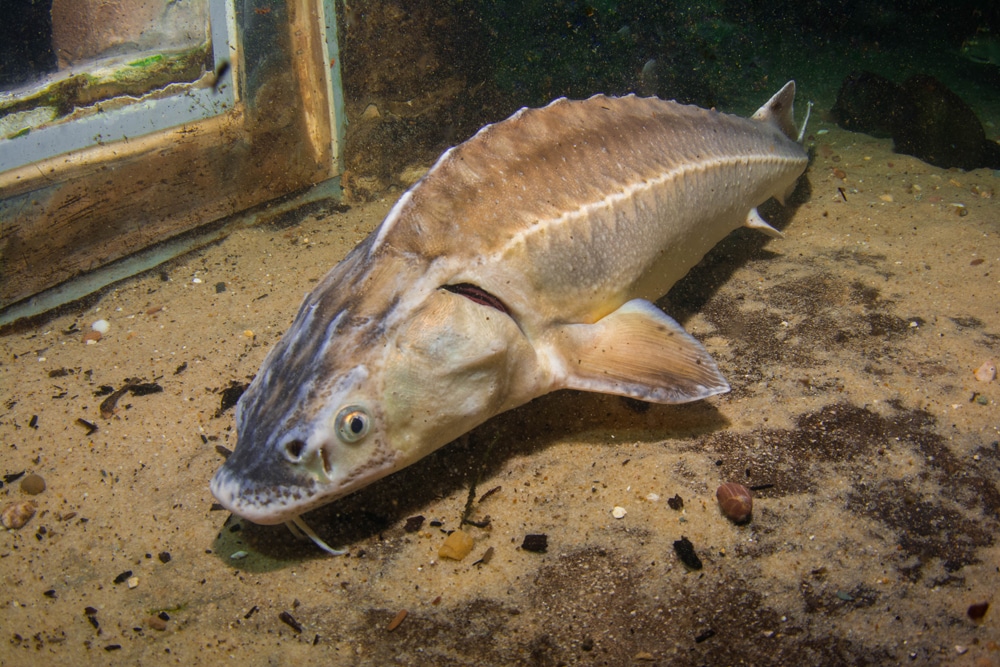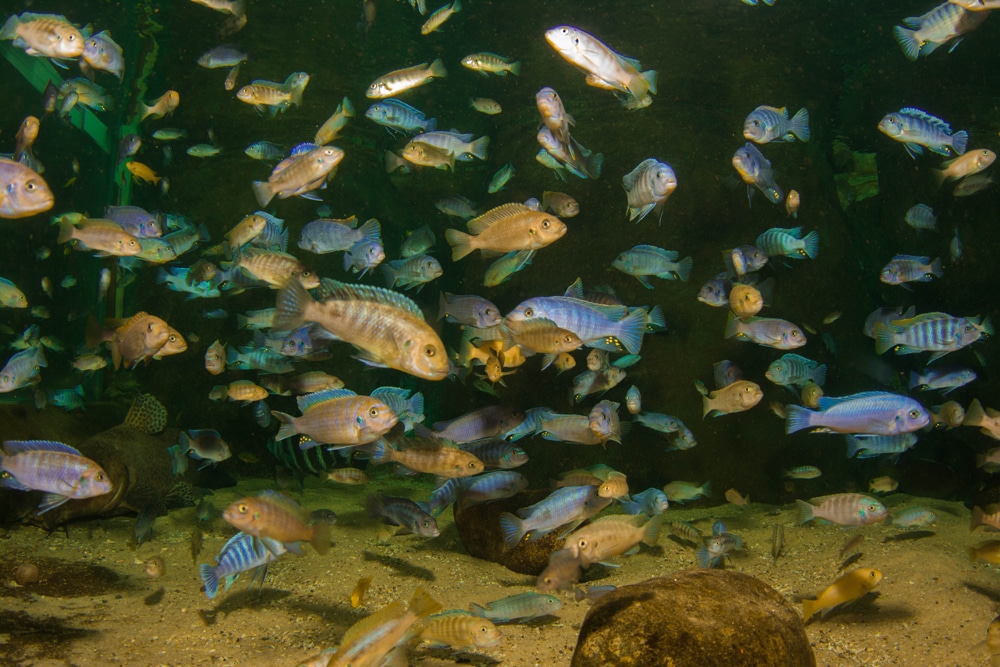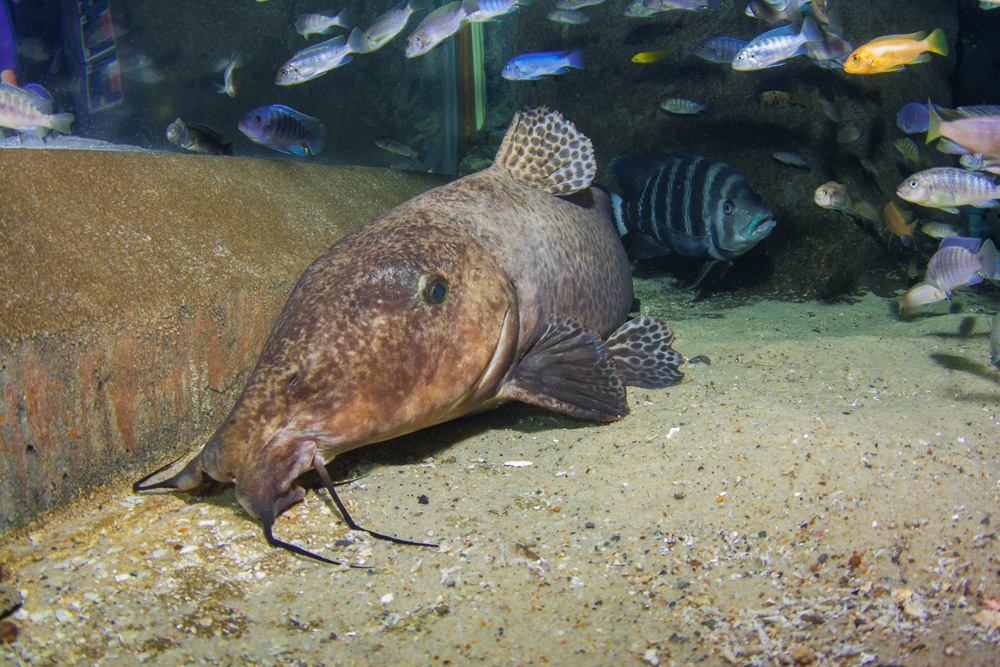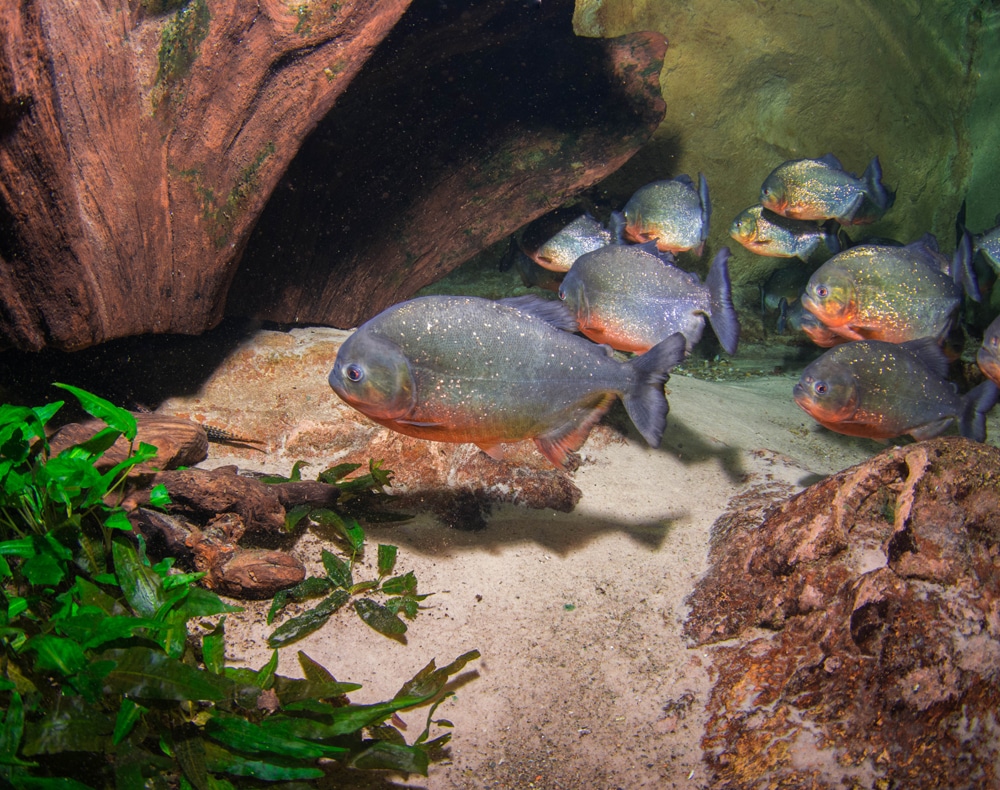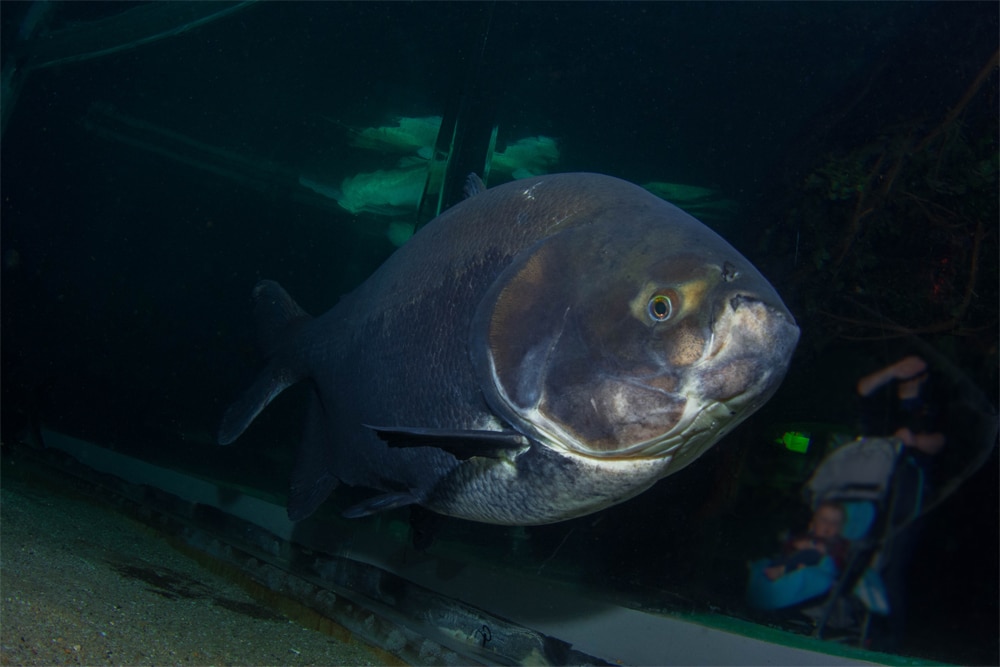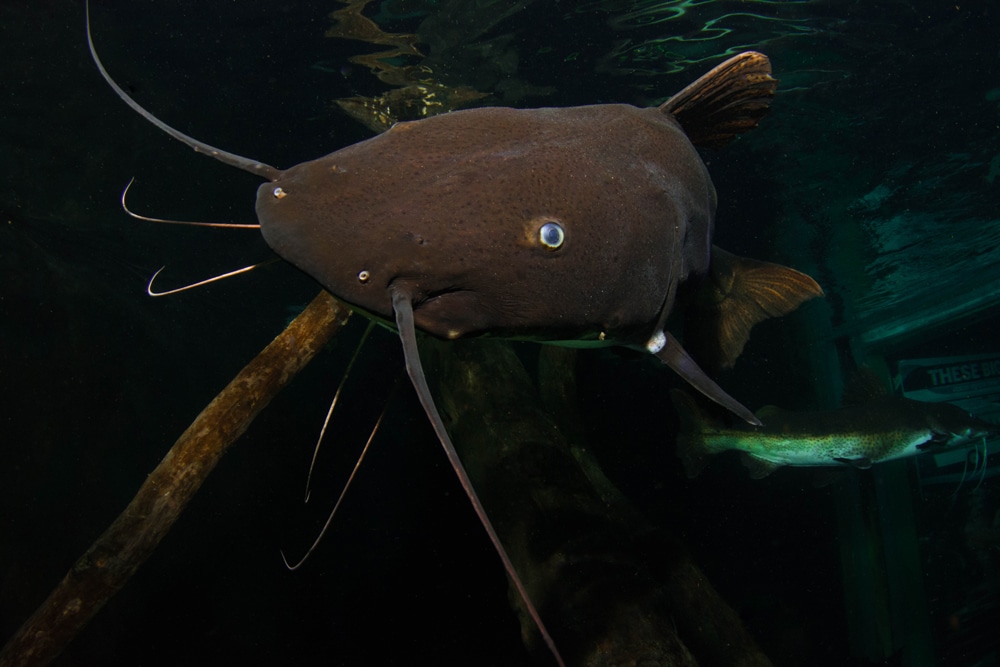Marine Life & Conservation Blogs
Blue Planet Aquarium’s Freshwater Oddballs

In the last few Blogs I’ve covered our Main Tank here at Blue Planet quite extensively, but I haven’t really managed to show you some of our other inhabitants. In this blog I want to show you some of the animals we have in our freshwater tanks and seen as half of the Aquarium is freshwater its pretty fair to say that we have quite a few of them.
When Blue Planet Aquarium was built back in 1998 it was built to loosely replicate the water cycle, so our first area is an area that mimics highland streams and rivers, before it moves down through the Jungles and Rainforests, then into the world’s great Lakes and finally the mangrove swamps and brackish swamps… before finally ending up in the ocean.
The first area we’re going to talk about is the first zone at the aquarium and that’s Northern Streams. This area is themed around highland rivers and streams and is mainly British Freshwater species including Carp, Sticklebacks, Sturgeon and Silver Orfe. The exhibit is split into three sections with different species in each section. Each section is split by a wall with a small gap over the top with fast flowing water. This is to imitate the natural currents that the animals would get in the wild and they do have the option to swim over them if they want too.
In this exhibit we have around 250 Silver Orfe and a handful of Golden Orfe or as they’re otherwise globally known as “Ide”. They’re a species that need fast flowing water with lots of oxygen and swim between the three sections all the time. We also have Common and Silver Carp, which are a large relative of the Goldfish. Carp are famous through Course Fishing and are immensely powerful; they’re among peoples favourites due to their quite comical expressions and being one of the largest fish in Northern Streams.
My personal favourites in this area are the two species of Sturgeon: we have both Russian or “Diamond” Sturgeon and Siberian Sturgeon. You may be familiar with these guys as they’re a fish that look incredibly similar to a Shark and have been around for millions of years. We know this as they lack a first Dorsal fin in the same way that Six-gill and Seven-Gill Sharks do; these fish are also one of a few species from which we get Caviar. They are a bottom dwelling fish and feed by using their sensitive noses to forage through the mud for worms and small Crustaceans.
The next area is Lake Malawi (not the real one) but an area of the aquarium that’s themed around the great lake in Africa. Lake Malawi has a surface area of 29,600 km² and is 580km Long with its max depth being 700m. This makes Lake Malawi the ninth largest lake in the world and is the third largest and second deepest in Africa. Lake Malawi houses more fish species than any other lake in the world with the number of Cichlids alone sitting at around 1500sp although at Blue Planet we only a house a mere handful of these.
Cichlids are famous for the way in which they breed, Cichlids are known as mouth brooders as the females store/incubate and rear their young in their mouths. The females do this until the young start to become too large for all the Fry to be stored in the mouth and at this point she will start to kick them out so they can stretch their fins and build up their strength, but if they’re not quick enough to get back in when a predator comes then they are at risk of being eaten. Our Cichlids are housed alongside other animals such as a Giraffe Catfish who naturally would be found in the Nile River but were released into Lake Malawi. Ours is incredibly friendly and will come to the surface and wait, mouth agape, for his food.
The next and final area is of course the Amazon Area. Now if you were to walk through the aquarium you would go through this area first before Lake Malawi, but I wanted to leave the largest of our freshwater fish until last.
In this area we have some of our most charismatic Freshwater species such as our Red-Bellied Piranhas. These fish are surrounded by quite negative media attention which is something that isn’t deserved. The rumours surround that these fish eat people and can strip a human in 10 seconds but that is greatly exaggerated.
Piranhas are more scavengers and due to this are nicknamed the “Hyenas of the Amazon”. They prefer to eat the dead, dying or severely injured, this is due to their small size and the fact that they are not very high up the food chain, meaning that they’re targeted by many predators that live in the Amazon. They usually send up a scout to check the prey or food and once the scout has taken the first bite to show its clear, the rest of the pack follow. A Piranhas’ bite is incredibly powerful and so powerful that in comparison to body size, Red-Bellied Piranhas have a stronger bite than that of T-Rex and Megalodon. The myth that they can strip a human in seconds is mainly science fiction, but they can still strip a small carcass in just a few minutes.
The final Exhibit I’m going to mention is the Flooded Forest tank. This is the one that houses the aquarium’s largest freshwater fish. In this tank we have some of the most charismatic and popular fish in the aquarium, such as the Black Pacu, which is the world’s largest species of Piranha. When these fish are young they have bright red bellies to mimic the Red-Bellied Piranha and as they get bigger they lose this colour and turn a dark colour.
People buy these fish thinking that they’re getting Piranhas, but owners soon realise there’s something amiss when they swap some meat for some carrots and cabbage. They can also grow up to be around 3 ½ Feet in length and weigh in at a hefty 60 pounds, we have one in the exhibit around this size that has come to be called “Moby”. The tank is home to a number of fish that have been rescued over the years and a lot of the fish in the tank were all either mis-sold or sold under a false name, leading to the tank being nicknamed ‘Tank Busters’. Sharing the tank with the Pacu’s we also have Tiger Shovelnose Catfish who were very intent on looking at their reflection in the dome port of my camera when I got in to take some of the photos used in this blog. Once again these fish are also rescues from owners who could no longer care for them.
We also have a handful of Silver Arowana and of course the Freshwater Stingrays. We have two species at Blue Planet: the Amazonian Stingray which is Brown with orange spots and the Xingu River Ray which is black with white spots. These Stingrays have the slightly annoying habit of trying to sleep under your feet when you’re trying to clean the windows and sand, so we must be extra careful not to step on them.
So, there you have it, our Freshwater Oddballs here at Blue Planet Aquarium. It’s amazing to have several different species over many different environments and I’m glad that I have been able to introduce you to some of the aquarium’s different inhabitants. Check out the next blog to meet our Jellyfish Breeder and to see how we breed our Moon Jellyfish.
For more information about the Blue Planet Aquarium please visit their website by clicking here.
Marine Life & Conservation Blogs
Creature Feature: Dusky Shark

 In this series, the Shark Trust will be sharing amazing facts about different species of sharks and what you can do to help protect them.
In this series, the Shark Trust will be sharing amazing facts about different species of sharks and what you can do to help protect them.
This month we’re taking a look at the Dusky Shark, a highly migratory species with a particularly slow growth rate and late age at maturity.
Dusky sharks are one of the largest species within the Carcharhinus genus, generally measuring 3 metres total length but able to reach up to 4.2 metres. They are grey to grey-brown on their dorsal side and their fins usually have dusky margins, with the darkest tips on the caudal fin.
Dusky Sharks can often be confused with other species of the Carcharhinus genus, particularly the Galapagos Shark (Carcharhinus galapagensis). They have very similar external morphology, so it can be easier to ID to species level by taking location into account as the two species occupy very different ecological niches – Galapagos Sharks prefer offshore seamounts and islets, whilst duskies prefer continental margins.
Hybridisation:
A 2019 study found that Dusky Sharks are hybridising with Galapagos Sharks on the Eastern Tropical Pacific (Pazmiño et al., 2019). Hybridisation is when an animal breeds with an individual of another species to produce offspring (a hybrid). Hybrids are often infertile, but this study found that the hybrids were able to produce second generation hybrids!
Long distance swimmers:
Dusky sharks are highly mobile species, undertaking long migrations to stay in warm waters throughout the winter. In the Northern Hemisphere, they head towards the poles in the summer and return southwards towards the equator in winter. The longest distance recorded was 2000 nautical miles!
Very slow to mature and reproduce:
The Dusky Shark are both targeted and caught as bycatch globally. We already know that elasmobranchs are inherently slow reproducers which means that they are heavily impacted by overfishing; it takes them so long to recover that they cannot keep up with the rate at which they are being fished. Dusky Sharks are particularly slow to reproduce – females are only ready to start breeding at roughly 20 years old, their gestation periods can last up to 22 months, and they only give birth every two to three years. This makes duskies one of the most vulnerable of all shark species.
The Dusky Shark is now listed on Appendix II of the Convention on the Conservation of Migratory Species (CMS), but further action is required to protect this important species.
Scientific Name: Carcharhinus obscurus
Family: Carcharhinidae
Maximum Size: 420cm (Total Length)
Diet: Bony fishes, cephalopods, can also eat crustaceans, and small sharks, skates and rays
Distribution: Patchy distribution in tropical and warm temperate seas; Atlantic, Indo-Pacific and Mediterranean.
Habitat: Ranges from inshore waters out to the edge of the continental shelf.
Conservation status: Endangered.
For more great shark information and conservation visit the Shark Trust Website
Images: Andy Murch
Diana A. Pazmiño, Lynne van Herderden, Colin A. Simpfendorfer, Claudia Junge, Stephen C. Donnellan, E. Mauricio Hoyos-Padilla, Clinton A.J. Duffy, Charlie Huveneers, Bronwyn M. Gillanders, Paul A. Butcher, Gregory E. Maes. (2019). Introgressive hybridisation between two widespread sharks in the east Pacific region, Molecular Phylogenetics and Evolution 136(119-127), https://doi.org/10.1016/j.ympev.2019.04.013.
Marine Life & Conservation Blogs
Creature Feature: Undulate Ray

 In this series, the Shark Trust will be sharing amazing facts about different species of sharks and what you can do to help protect them.
In this series, the Shark Trust will be sharing amazing facts about different species of sharks and what you can do to help protect them.
This month we’re looking at the Undulate Ray. Easily identified by its beautiful, ornate pattern, the Undulate Ray gets its name from the undulating patterns of lines and spots on its dorsal side.
This skate is usually found on sandy or muddy sea floors, down to about 200 m deep, although it is more commonly found shallower. They can grow up to 90 cm total length. Depending on the size of the individual, their diet can range from shrimps to crabs.
Although sometimes called the Undulate Ray, this is actually a species of skate, meaning that, as all true skates do, they lay eggs. The eggs are contained in keratin eggcases – the same material that our hair and nails are made up of! These eggcases are also commonly called mermaid’s purses and can be found washed up on beaches all around the UK. If you find one, be sure to take a picture and upload your find to the Great Eggcase Hunt – the Shark Trust’s flagship citizen science project.
It is worth noting that on the south coasts, these eggcases can be confused with those of the Spotted Ray, especially as they look very similar and the ranges overlap, so we sometimes informally refer to them as ‘Spundulates’.
Scientific Name: Raja undulata
Family: Rajidae
Maximum Size: 90cm (total length)
Diet: shrimps and crabs
Distribution: found around the eastern Atlantic and in the Mediterranean Sea.
Habitat: shelf waters down to 200m deep.
Conservation Status : As a commercially exploited species, the Undulate Ray is a recovering species in some areas. The good thing is that they have some of the most comprehensive management measures of almost any elasmobranch species, with both minimum and maximum landing sizes as well as a closed season. Additionally, targeting is entirely prohibited in some areas. They are also often caught as bycatch in various fisheries – in some areas they can be landed whilst in others they must be discarded.
IUCN Red List Status: Endangered
For more great shark information and conservation visit the Shark Trust Website
Image Credits: Banner – Sheila Openshaw; Illustration – Marc Dando
-

 News3 months ago
News3 months agoHone your underwater photography skills with Alphamarine Photography at Red Sea Diving Safari in March
-

 News3 months ago
News3 months agoCapturing Critters in Lembeh Underwater Photography Workshop 2024: Event Roundup
-

 Marine Life & Conservation Blogs3 months ago
Marine Life & Conservation Blogs3 months agoCreature Feature: Swell Sharks
-

 Blogs2 months ago
Blogs2 months agoMurex Resorts: Passport to Paradise!
-

 Blogs2 months ago
Blogs2 months agoDiver Discovering Whale Skeletons Beneath Ice Judged World’s Best Underwater Photograph
-

 Marine Life & Conservation2 months ago
Marine Life & Conservation2 months agoSave the Manatee Club launches brand new webcams at Silver Springs State Park, Florida
-

 Gear Reviews3 months ago
Gear Reviews3 months agoGear Review: Oceanic+ Dive Housing for iPhone
-

 Gear Reviews2 weeks ago
Gear Reviews2 weeks agoGEAR REVIEW – Revolutionising Diving Comfort: The Sharkskin T2 Chillproof Suit


